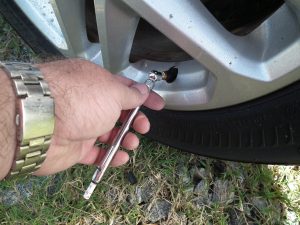How to Check Tire Pressure and Inflate Accordingly
Posted Tuesday, Nov 27, 2018
Often, we jump into our vehicles and motor off without thinking about checking anything on our cars beforehand. One that’s important to know is how to check tire pressure. You may feel that this is a moot point if your auto is equipped with a tire pressure monitoring system (TPMS), but those systems malfunction occasionally. So, what are the risks in driving with a tire that is incorrectly inflated? At minimum, you will wear that tire unevenly and, hence, decrease its life. When a tire is under-inflated, the shoulders carry the brunt of the weight, so the outside edges of your tread will wear away while the center tread remains intact. If it is under-inflated enough, the sidewall will be overworked and will eventually fail; you’ll have a flat that is irreparable. When a tire is over-inflated, the center carries the brunt of the weight, so the center tread will wear away while the shoulder tread remains intact. If it’s over inflated enough, the pressure and heat will cause a blowout, which obviously cannot be repaired. But in any of the cases, the tire will not last as long as it might have. So, check your tires periodically using these steps:
 1. Check to see how much pressure your tires should have for your particular vehicle. Many people simply look at the maximum rated pressure listed on the tire itself and inflate to that amount. However, this will, in many cases, result in a tire that is incorrectly inflated. Instead, open the driver’s door and find the decal that lists the recommended tire pressure for the rear and front tires; often, this decal has a small wheel pictured in the upper left corner and will be entitled “Tire and Loading Information.” To illustrate the difference between the psi (pounds per square inch) listed on the tire and the Tire and Loading Information decal, I just looked at a car and an SUV. The car’s tires state a maximum inflation pressure of 51 psi, but its decal stated a recommended inflation pressure of 33 psi. With the SUV, the pressures were 44 and 32 psi, respectively. As you can see, you need to go by the decal.
1. Check to see how much pressure your tires should have for your particular vehicle. Many people simply look at the maximum rated pressure listed on the tire itself and inflate to that amount. However, this will, in many cases, result in a tire that is incorrectly inflated. Instead, open the driver’s door and find the decal that lists the recommended tire pressure for the rear and front tires; often, this decal has a small wheel pictured in the upper left corner and will be entitled “Tire and Loading Information.” To illustrate the difference between the psi (pounds per square inch) listed on the tire and the Tire and Loading Information decal, I just looked at a car and an SUV. The car’s tires state a maximum inflation pressure of 51 psi, but its decal stated a recommended inflation pressure of 33 psi. With the SUV, the pressures were 44 and 32 psi, respectively. As you can see, you need to go by the decal.
2. Remove the valve stem cap from the first tire and place it where it will not be lost. I often place it on top of the tire itself.
3. Push the opening of the tire pressure gauge firmly over the end of the valve stem and compare the reading to the recommended pressure you found listed on the decal. These steps illustrate, technically, how to check tire pressure, but you may or may not need to adjust this pressure. If the tire is correctly inflated, skip to step 6. If it’s under-inflated, proceed to step 4. If it’s over inflated, move to step 5.
4. For under-inflation: Firmly push the opening of the air chuck (the apparatus on the end of the air hose that allows air to be added to a tire) over the end of the valve stem. You should hear air being forced into the tire. After a few seconds, remove the air chuck and press the air gauge over the stem again. If it still needs air, press the air chuck on the stem again for a few seconds, and then check. Continue adding air and checking pressure until it meets the recommended pressure. When it’s properly inflated, go to step 6. If you’ve accidentally added too much air, proceed to step 5.
5. For over-inflation: Press the back side of the air chuck, which should simply have a short stem protruding outwards, against the end of the valve stem; you should hear air hissing from the valve stem as it relieves pressure. After a few seconds, remove the air chuck and press the air gauge over the stem again. If it’s still over-inflated, release more air as described before, and then check again. Continue releasing air and checking pressure until it meets the recommended pressure. When it’s properly inflated, proceed to step 6.
6. Replace the valve stem cap and then move to the next tire. At this point, you’ll repeat steps 2 through 6 until you’ve checked all four tires. Additionally, I recommend checking the spare sometimes. I once had a flat tire on the interstate and found that my spare was also deflated when I removed it from the trunk- it was not a happy time!
So, now you know how to check tire pressure and how to inflate the tires accordingly. To learn the steps for checking proper oil levels, another vital check you should periodically perform, read our next post.
Photo courtesy of reasonablerides.com